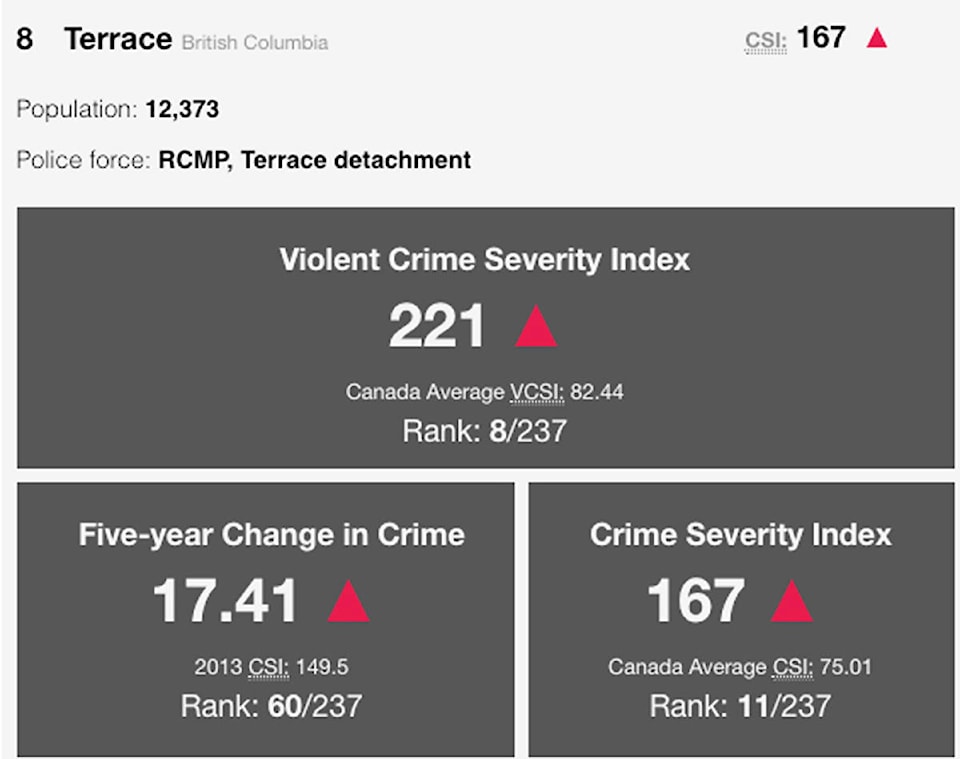Terrace has jumped from being the 79th most dangerous city in Canada last year to the eighth most dangerous this year.
Close on its heels is Prince Rupert, which jumped from 223 last year, to the 11th spot this year.
According to Maclean’s Magazine annual Crime Severity Index (CSI) report, released on November 19, Terrace’s CSI rose from 134 in 2017 to 166 in 2018, despite a decrease in the number of reported assaults from 213 in 2017 to 187 in 2018. Prince Rupert, which recorded a significant drop in its CSI to 122 in 2016, crept back up to a CSI of 134 in 2017 and 140 in 2018.
The report is compiled using Statistic Canada’s (StatsCan) Uniform Crime Reporting Survey, data on all crimes reported by police during the course of a year, data which is freely available on their website.
While Kitimat doesn’t feature in the list of 237 cities ranked by Macleans – the magazine only focuses on towns with a population of over 10,000 – the town has nevertheless seen an increase in its CSI.
Terrace
Despite fears that the legalization of cannabis in 2018 would drive up the rate of impaired drivers caught behind the wheel, Terrace only registered an increase of three incidents, from 45 in 2017 to 48 in 2018. Youth crime is down, from four incidents in 2017 to two in 2018.
These are some of the factors that drove Terrace’s CSI to its new heights:
* Homicide – no homicides in 2017, one in 2018
* Sexual assaults – up from 13 in 2017, to 22 in 2018
* Breaking and entering - up from 47 in 2017, to 53 in 2018
* Fraud – up from 53 in 2017, to 76 in 2018.
Kitimat
According to StatsCan, Kitimat’s CSI for 2018 jumped from just over 77 in 2017 to nearly 93 in 2018, a 19.68 per cent increase, compared to 2016 and 2017’s modest increases of 1,4 per cent and 8,12 per cent respectively.
The percentage increase in the total CSI was driven by an increase of nearly 27 per cent in non-violent crime severity index in 2018, crimes which include traffic and drug violations, and violations of Federal Statutes.
Among those crimes Kitimat saw an increase in impaired driving violations from 28 in 2017, to 38 in 2018.
The violent crime index, however, decreased significantly, from 41 per cent in 2017 down to nine per cent in 2018.
The violent crime severity index tracks the number of violent crimes, including homicide, attempted murder, sexual and physical assault, uttering threats, criminal harassment and forcible confinement, reported by police.
Assaults decreased from 86 in 2017 to 72 in 2018, as did breaking and entering – from 23 in 2017 to 15 in 2018.
Prince Rupert
The 2018 CSI for Prince Rupert comes despite a drop in homicides from two in 2017 to none in 2018. The main contributor to the sharp rise in the city’s CSI was an increase in assaults from 245 in 2017, to 319 in 2018.
These are some of the other factors that drove up Prince Rupert’s CSI:
* Sexual assault – up from 18 in 2017, to 22 in 2018
* Breaking and entering – up from 36 in 2017, to 56 in 2018
* Fraud – up from 37 in 2017, to 60 in 2018
* Cocaine trafficking or production – up from two in 2017, to 12 in 2018.
Nationally
Top spot in the Canada-wide 2019 CSI rankings went to Thompson, Manitoba, with a CSI of 570. Last year the top-ranking city was Wetaskiwin in Alberta.
What IS the CSI?
According to Statistics Canada (StatsCan), the Crime Severity Index tracks changes in the severity of police-reported crime.
StatsCan takes into consideration the number of crimes as well as the seriousness of those crimes to generate the CSI.
To do this, crimes are weighted according to their severity – more serious crimes are assigned higher weights, less serious offences lower weights. For example, a murder would receive a weight 1,000 times higher than a case of shoplifting.
The weight consists of two parts – the number of people convicted and sentenced to time in prison, multiplied by the average time they spend in prison.
Each crime receives the same weight regardless of the specific outcome of any individual case – for example, all robberies reported by police carry the same weight in the CSI. The weights are calculated using the five most recent years of available sentencing data.
To finally calculate the CSI, the number of crimes is multiplied by the weight for that crime, the final figure divided by the corresponding population total. To make the CSI easier to interpret, it is standardized to 100 for Canada.
READ MORE: Terrace Crime Severity Index spikes 25 per cent
READ MORE: 85-year-old man killed on Soucie Avenue
